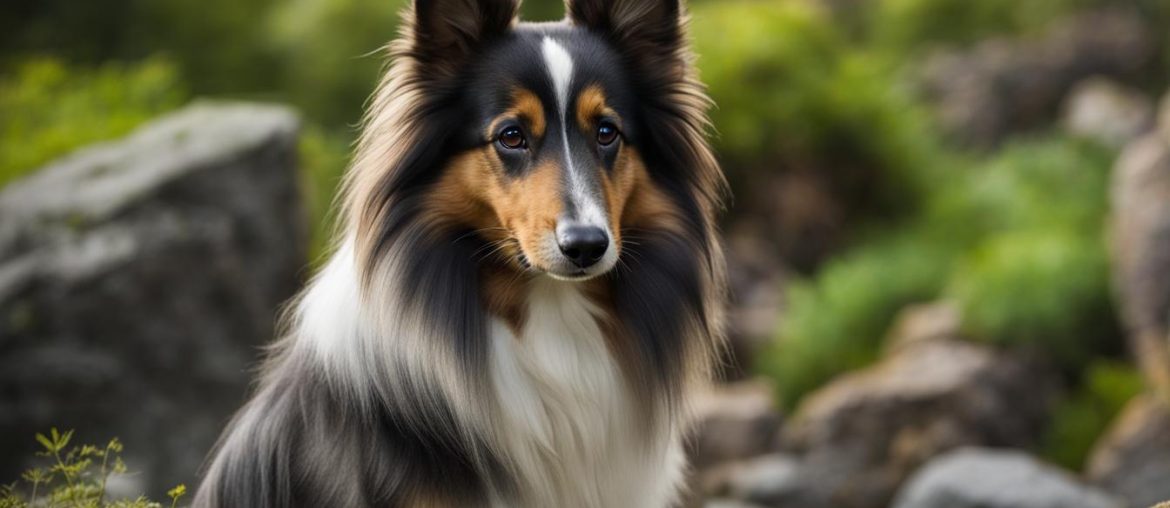The Shetland Sheepdog, also known as the “Sheltie,” is a remarkable dog breed that is highly regarded for its intelligence, loyalty, and elegance. They are quick learners and have a strong desire to please their owners. Shelties are known for their adaptability and excel in various training endeavors, making them ideal candidates for dog sports and competitions. Their high intelligence and eagerness to please also make them highly trainable using positive reinforcement methods.
Key Takeaways:
- The Shetland Sheepdog is an intelligent and loyal dog breed.
- They are quick learners and have a strong desire to please their owners.
- Shelties excel in various training endeavors.
- Positive reinforcement methods are highly effective in training Shelties.
- They are adaptable and make excellent candidates for dog sports and competitions.
Sheltie Breed Traits and Characteristics

Shetland Sheepdogs, also known as Shelties, possess a unique set of traits and characteristics that make them a beloved breed among dog enthusiasts. These intelligent and elegant dogs have a small to medium-sized build, typically weighing between 14 to 27 pounds. They are known for their beautiful long double coat, which comes in various colors such as sable, black, and blue merle.
While Shetland Sheepdogs are affectionate and loyal, they can be cautious around strangers due to their herding instincts. This makes them excellent family dogs as they tend to be devoted and protective towards their loved ones. However, early socialization is essential to ensure they grow up to be well-rounded and friendly towards other people and animals.
Regular exercise is important for Shelties to keep them physically and mentally stimulated. They thrive when given opportunities to participate in activities that engage their intelligence, such as obedience training and dog sports like agility. Shelties are eager to please their owners and excel in training programs that use positive reinforcement methods.
| Shetland Sheepdog Characteristics | Shetland Sheepdog Traits | Sheltie Behavior |
|---|---|---|
| Affectionate | Intelligent | Devoted to their families |
| Loyal | Adaptable | Can be reserved around strangers |
| Athletic | Quick Learners | Prone to herding behaviors |
Shetland Sheepdogs are hailed for their affectionate nature, intelligence, and loyalty. Their adaptability and quick learning abilities make them excellent candidates for various training endeavors. While they may be reserved around strangers, they are known to form deep bonds with their families. Regular exercise, mental stimulation, and positive reinforcement training methods are key to keeping these remarkable dogs happy and well-behaved.
Choosing a Shetland Sheepdog Puppy or Adopting from a Rescue
When it comes to bringing a Shetland Sheepdog into your home, there are two main options to consider: choosing a Shetland Sheepdog puppy from a reputable breeder or adopting from a rescue organization or shelter. Both options have their advantages, so it’s important to weigh them carefully before making a decision.
If you decide to purchase a Shetland Sheepdog puppy, finding a reputable breeder is crucial. A reputable breeder will prioritize the well-being of their dogs and conduct necessary health screenings to ensure the puppies are healthy. They will also provide a nurturing environment for the puppies and socialize them from a young age. It’s important to do thorough research and ask for references to ensure that the breeder follows ethical breeding practices.
On the other hand, adopting a Shetland Sheepdog from a rescue organization or shelter provides a loving home to a dog in need. There are many Shelties waiting for their forever homes, and by adopting, you are giving them a second chance at a happy life. Rescue organizations often provide the necessary vaccinations, spaying/neutering, and microchipping for the dogs in their care. Additionally, adopting a Sheltie can be a rewarding experience as you witness their transformation and see the impact your love and care have on their lives.
| Choosing a Shetland Sheepdog Puppy | Adopting from a Rescue |
|---|---|
| Opportunity to raise the puppy from a young age and shape their behavior | Providing a loving home to a dog in need |
| Ability to choose a specific breed and select a puppy with desired traits | Opportunity to help reduce the number of homeless dogs |
| Ensuring proper socialization and training from an early stage | Often comes with the necessary vaccinations, spaying/neutering, and microchipping |
Ultimately, whether you choose to get a Shetland Sheepdog puppy or adopt from a rescue, the most important thing is to provide a loving and caring environment for your new furry friend. With proper care, training, and attention, Shelties can become cherished members of your family and bring you years of joy and companionship.
Shetland Sheepdog Exercise and Training Needs
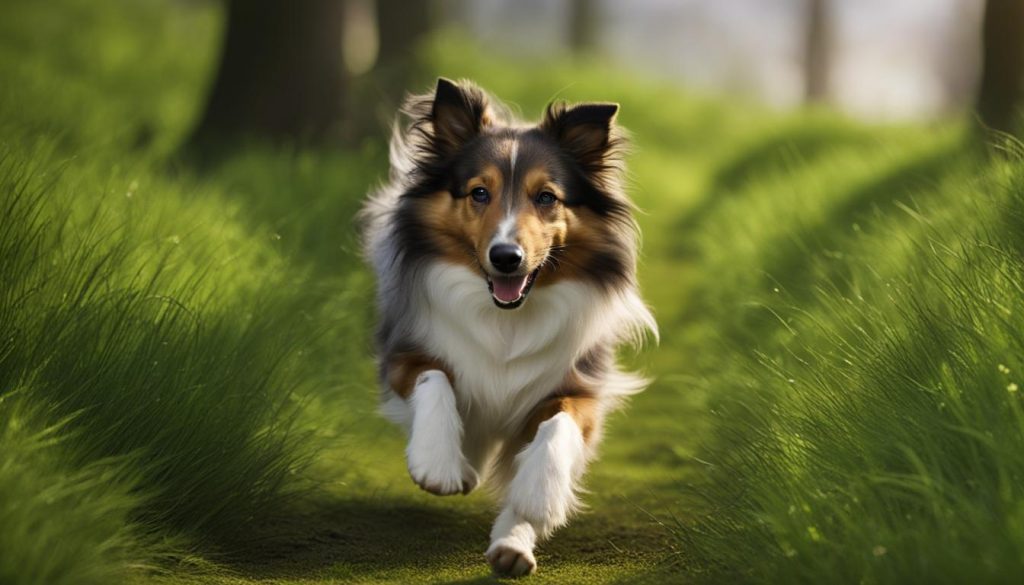
When it comes to exercise and training, Shetland Sheepdogs have specific needs that must be met to ensure their overall well-being and happiness. These intelligent and energetic dogs require regular physical activity and mental stimulation to thrive.
Exercise Needs
Shelties are moderate in terms of exercise requirements, but they still need daily walks and playtime to burn off energy and stay fit. A tired Sheltie is a happy Sheltie! To keep them mentally engaged, consider incorporating interactive play, such as fetch or puzzle toys. These activities satisfy their natural instincts and prevent boredom.
Additionally, Shetland Sheepdogs enjoy participating in dog sports, which provide them with both physical and mental challenges. Agility, obedience training, and rally are excellent options to consider. These activities not only keep the Sheltie physically active but also stimulate their intelligence and allow them to showcase their natural talents.
Training
Shetland Sheepdogs are highly trainable due to their intelligence and eagerness to please their owners. Positive reinforcement methods, such as treats, praise, and rewards, work exceptionally well with these dogs. They respond best to gentle and consistent training techniques that focus on positive reinforcement rather than punishment.
It is essential to start training Shelties from an early age and continue with consistent and regular sessions throughout their lives. Basic obedience commands, such as sit, stay, and come, should be mastered first before progressing to more advanced training exercises. Providing mental challenges and incorporating problem-solving activities also helps keep their minds sharp.
| Exercise Needs | Training Tips |
|---|---|
| Regular walks and playtime | Use positive reinforcement methods |
| Participation in dog sports | Start training from an early age |
| Interactive play and puzzle toys | Be consistent and patient |
Remember, training should be a positive and enjoyable experience for both you and your Shetland Sheepdog. Building a strong bond through training sessions creates a trusting and well-behaved companion.
Shetland Sheepdog Grooming and Coat Care

Grooming and coat care are essential aspects of keeping a Shetland Sheepdog looking and feeling its best. The Sheltie’s long, double coat requires regular maintenance to prevent matting and keep it in optimal condition.
To maintain the Shetland Sheepdog’s beautiful coat, regular brushing is a must. Use a slicker brush or a comb with medium teeth to gently remove tangles and prevent matting. Pay extra attention to the feathering on the legs and the mane around the neck. Brushing should be done at least two to three times a week, but during shedding seasons, daily brushing is recommended to remove loose hair and keep the coat looking tidy.
In addition to regular brushing, occasional baths are necessary to keep the Sheltie’s coat clean and healthy. Use a dog-specific shampoo and conditioner and ensure thorough rinsing. It’s important to dry the coat completely after a bath to prevent moisture from getting trapped close to the skin, which can lead to skin irritations.
When grooming a Shetland Sheepdog, attention should also be given to their ears, teeth, and nails. Regularly check the ears for any signs of infection and clean them gently using a dog-safe ear cleaner. Brushing the teeth regularly with a dog toothbrush and toothpaste helps maintain good dental hygiene. Trim the nails regularly to keep them at a comfortable length, being cautious not to cut into the quick.
Grooming Tips for Shetland Sheepdogs:
- Brush the coat two to three times a week, and daily during shedding seasons.
- Use a slicker brush or a comb with medium teeth to remove tangles and prevent matting.
- Give occasional baths using a dog-specific shampoo and conditioner.
- Clean the ears regularly and check for signs of infection.
- Brush the teeth regularly with a dog toothbrush and toothpaste.
- Trim the nails regularly to maintain a comfortable length.
| Grooming Aspect | Frequency |
|---|---|
| Brushing the coat | Two to three times a week; daily during shedding seasons |
| Bathing | Occasional baths using a dog-specific shampoo and conditioner |
| Ear cleaning | Regularly; check for signs of infection |
| Teeth brushing | Regularly with a dog toothbrush and toothpaste |
| Nail trimming | Regularly to maintain a comfortable length |
Shetland Sheepdog Health Considerations
When it comes to caring for a Shetland Sheepdog’s health, it is important to be aware of the common health issues that can affect this breed. By understanding these potential issues and taking appropriate measures, you can help ensure the well-being and longevity of your Sheltie companion.
One of the common health problems that Shetland Sheepdogs can be prone to is hip dysplasia. This condition occurs when the hip joint doesn’t develop properly, leading to discomfort and potential mobility issues. Regular veterinary check-ups can help identify any signs of hip dysplasia early on, allowing for appropriate management and treatment.
Another health concern for Shelties is the development of certain eye conditions such as progressive retinal atrophy and cataracts. Progressive retinal atrophy is a degenerative disease that can lead to vision loss over time. Cataracts, on the other hand, cause clouding of the lens, leading to impaired vision. Regular eye examinations by a veterinarian can help monitor and manage these conditions if they arise.
In addition, Shetland Sheepdogs may be prone to allergies, which can manifest as skin irritations, itchiness, or digestive issues. Identifying and eliminating potential allergens from their environment, such as certain foods or environmental triggers, can help manage these allergies. It’s important to work closely with your veterinarian to develop a tailored care plan for your Sheltie’s specific needs.
| Common Health Issues | Symptoms | Treatment |
|---|---|---|
| Hip Dysplasia | Lameness, difficulty in getting up and down, decreased activity | Medication, weight management, physical therapy, surgery |
| Progressive Retinal Atrophy | Night blindness, dilated pupils, changes in eye color | No cure; regular check-ups, vision support, environmental management |
| Cataracts | Cloudy or opaque lens, decreased vision or blindness | Surgery to remove cataracts, regular eye examinations |
| Allergies | Itchy skin, rashes, digestive issues | Identifying and avoiding triggers, medications, hypoallergenic diet |
“Regular veterinary care is essential for the overall health and well-being of your Shetland Sheepdog. By staying proactive and addressing any health concerns promptly, you can help ensure a happy and healthy life for your beloved Sheltie.”
Shetland Sheepdog Temperament and Behavior
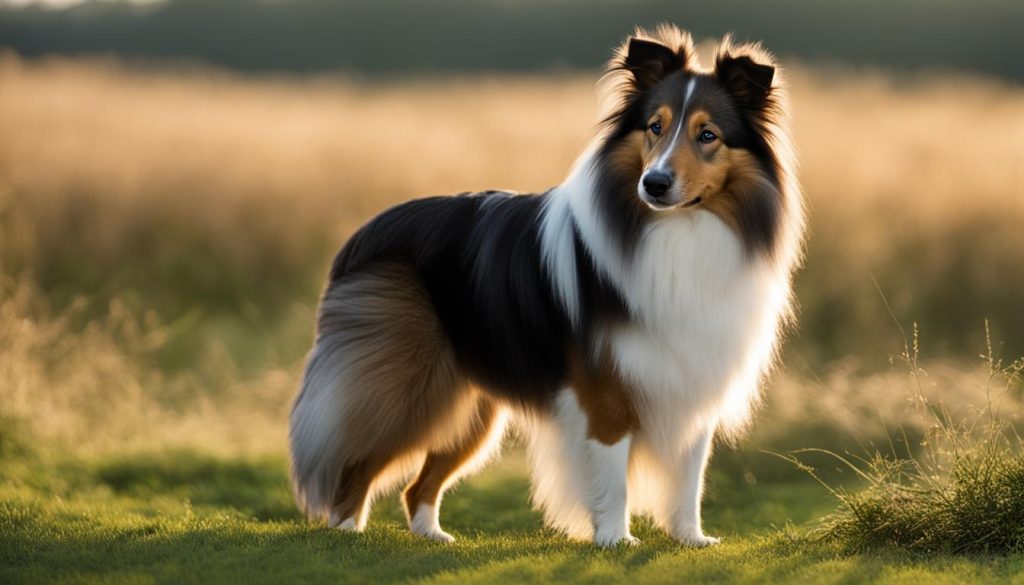
The Shetland Sheepdog, also known as the Sheltie, is a breed known for its delightful temperament and charming behavior. Shelties are intelligent and affectionate dogs, forming strong bonds with their owners. They are loyal and devoted, always seeking to please their families. With their playful nature, they bring joy and happiness to any household.
While Shelties may be reserved with strangers, they are generally not aggressive. Their cautiousness around new people stems from their herding instincts, which make them protective of their loved ones. They are excellent family dogs, gentle and patient with children.
One notable behavior of the Shetland Sheepdog is their herding tendencies. Shelties may exhibit circling and nipping behaviors, especially towards children or other pets. This is a result of their natural instinct to herd and control movement. It’s important to redirect this behavior through proper training and socialization to ensure they understand appropriate boundaries.
Shetland Sheepdog Appearance and Physical Characteristics

The Shetland Sheepdog, also known as the Sheltie, is a breed that boasts a graceful build and captivating physical features. These characteristics contribute to the breed’s overall elegance and intelligence. Shelties have a small to medium-sized frame, typically weighing between 14 to 27 pounds, which makes them a suitable choice for families living in apartments or smaller homes.
One of the most striking features of the Shetland Sheepdog is its long, double coat. The dense undercoat helps protect the breed from harsh weather conditions, while the outer coat is soft and provides a beautiful, flowing appearance. Shelties come in various coat colors, including sable, black, and blue merle, which adds to their charm and individuality.
Their expressive eyes, perked high ears, and plumed tail are distinguishing physical traits. These features contribute to the breed’s alert and attentive expression, showcasing their intelligence and ability to be observant of their surroundings. The combination of their physical attributes and their elegant gait provides a regal appearance that is often admired by dog enthusiasts.
| Physical Traits | Description |
|---|---|
| Size | Small to medium-sized |
| Weight | 14 to 27 pounds |
| Coat | Long, double coat with dense undercoat |
| Coat Colors | Sable, black, blue merle |
| Eye Color | Varies based on coat color |
| Ears | Perked high and mobile |
| Tail | Plumed and carried low |
The Shetland Sheepdog’s physical traits not only contribute to their appearance but also complement their intelligent and affectionate nature. Their regal presence and captivating coat colors make them a delightful addition to any family.
Sheltie Affection and Family Bonds
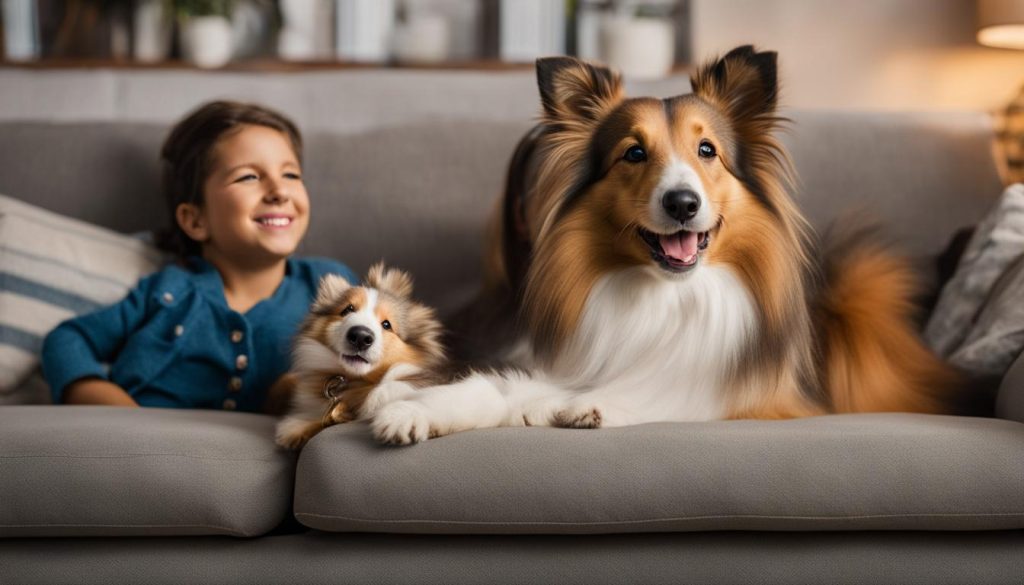
Shetland Sheepdogs, or Shelties, are known for their loving and affectionate nature, making them the perfect family dogs. They form strong bonds with their owners and thrive on the love and attention they receive in return. Whether it’s cuddling on the couch, playing in the backyard, or going for long walks together, Shelties are happiest when they are by their family’s side.
One of the remarkable qualities of Shelties is their ability to connect with both adults and children. They are patient and gentle with kids, making them excellent companions for families with young children. Shelties are known for their protective instincts and will go above and beyond to ensure the safety and well-being of their loved ones.
When you bring a Sheltie into your home, you can expect unwavering loyalty and devotion. They thrive on the close bonds they form with their families and will shower them with affection at every opportunity. Whether it’s a wagging tail, a gentle nudge, or a heartfelt gaze, Shelties have a special way of showing their love that melts your heart.
Quotes:
“My Sheltie has become an inseparable part of our family. The love and affection she gives us are truly remarkable.” – Sheltie Owner
Key Points:
- Shelties are loving and affectionate dogs that form strong bonds with their families.
- They are patient and gentle with children, making them excellent family pets.
- Shelties thrive on close connections and show their love in unique ways.
| Key Traits | Description |
|---|---|
| Loving and Affectionate | Shelties are known for their loving nature and form strong attachments to their families. |
| Family Companions | They are patient and gentle with children, making them great family pets. |
| Devoted and Loyal | Shelties are devoted to their owners, providing unwavering loyalty and affection. |
Shetland Sheepdog Exercise Needs and Mental Stimulation
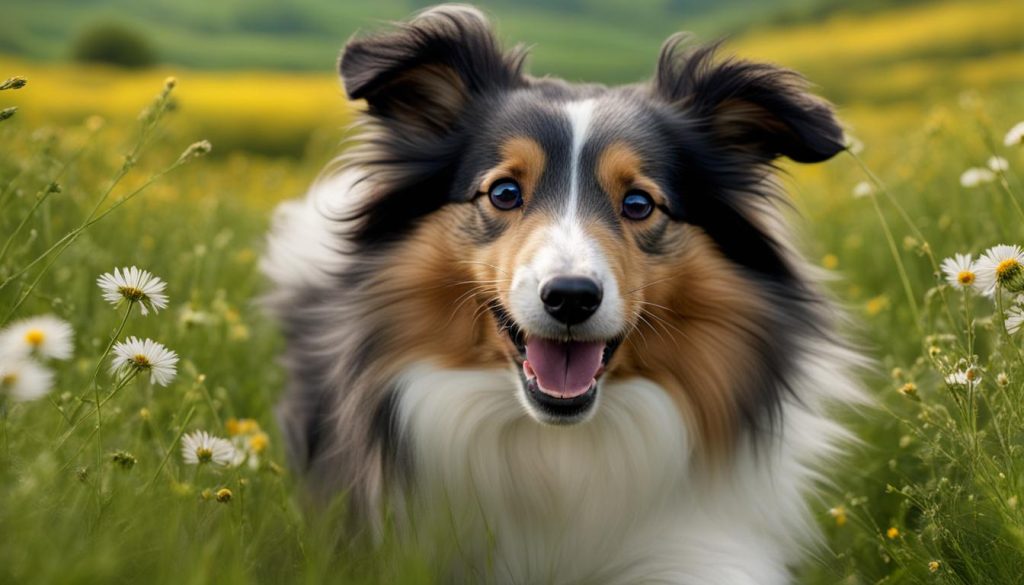
Ensuring that a Shetland Sheepdog receives proper exercise and mental stimulation is crucial to their overall well-being. These energetic and intelligent dogs thrive on activities that engage their minds and bodies. Without adequate exercise and mental stimulation, Shelties may become bored, leading to undesirable behaviors such as excessive barking or destructive chewing.
To meet their exercise requirements, daily walks or runs are essential. These should be combined with interactive play sessions, such as fetch or tug-of-war, to provide both physical and mental stimulation. Engaging in dog sports like agility or obedience training can further challenge and entertain a Shetland Sheepdog’s active mind. Additionally, puzzle toys or treat-dispensing toys can be used to keep them mentally engaged, as they love problem-solving activities.
Table: Shetland Sheepdog Exercise Recommendations
| Activity | Frequency | Duration |
|---|---|---|
| Walks or runs | At least once a day | 30-60 minutes |
| Interactive play | Daily | 15-30 minutes |
| Dog sports | 2-3 times a week | Varies (depending on the activity) |
In addition to physical exercise, it is equally important to engage a Shetland Sheepdog’s mind. Training sessions that focus on obedience and agility not only provide mental stimulation but also strengthen the bond between owner and dog. These sessions can be further enhanced by using positive reinforcement techniques, such as treats or praise, to encourage the desired behavior.
By incorporating a variety of activities that cater to both their physical and mental needs, Shetland Sheepdogs can lead happy and fulfilling lives. Regular exercise and mental stimulation not only prevent boredom and undesirable behaviors but also promote a healthier and well-balanced Sheltie.
Wrapping Up
The Shetland Sheepdog, with its intelligent and loyal personality, possesses a unique set of characteristics and behaviors that make it an excellent companion. From its high adaptability to its affectionate nature and deep devotion to its family, the Shetland Sheepdog brings joy and companionship to its owners. Understanding the Shetland Sheepdog’s personality, characteristics, and behavior is key to providing the best care and training for this remarkable breed.
With their intelligence and eagerness to please, Shetland Sheepdogs are quick learners and excel in various training endeavors. Their adaptability makes them ideal candidates for dog sports and competitions. Regular exercise, playtime, and mental stimulation are important to keep them happy and prevent boredom, allowing them to thrive both physically and mentally.
Grooming their beautiful double coats and addressing their specific health considerations are crucial in ensuring the overall well-being of Shetland Sheepdogs. Regular veterinary care, balanced nutrition, and a loving environment are necessary to maintain their good health and maximize their lifespan.
In summary, the Shetland Sheepdog’s personality, characteristics, and behavior make it a remarkable breed that brings immense joy and companionship to its owners. By understanding and meeting their needs, we can create a fulfilling and rewarding relationship with these intelligent and loyal dogs.
FAQ
What are the personality traits of the Shetland Sheepdog?
The Shetland Sheepdog is known for its intelligence, loyalty, and elegance. They are quick learners, eager to please, and adapt well to various training endeavors.
How much do Shelties typically weigh?
Shetland Sheepdogs usually weigh between 14 to 27 pounds, depending on their size and build.
What colors does the Shetland Sheepdog’s coat come in?
The Sheltie’s coat comes in various colors, including sable, black, and blue merle.
Are Shelties good with families?
Yes, Shetland Sheepdogs are known for their affectionate and loyal personalities, making them wonderful additions to family households.
What is the grooming requirement for a Shetland Sheepdog’s coat?
Shelties have a long double coat that requires regular brushing to prevent matting, especially during shedding seasons. Occasional baths and grooming are also needed to maintain their coat’s health and appearance.
Are there any common health issues in Shetland Sheepdogs?
Shetland Sheepdogs can be prone to health issues such as hip dysplasia, eye conditions like progressive retinal atrophy and cataracts, and allergies. Regular veterinary care and proper nutrition are important for their overall well-being.
Do Shetland Sheepdogs require a lot of exercise?
Shelties have moderate exercise requirements. Regular walks, playtime, and mental stimulation are important to keep them happy and prevent boredom.
What is the appearance of a Shetland Sheepdog?
Shetland Sheepdogs have a graceful build with a long, double coat. They come in various colors and have expressive eyes, perked high ears, and a plumed tail.
Are Shelties good with children?
Yes, Shetland Sheepdogs form deep bonds with their families, including children. They are known for their loyalty and affectionate nature towards all family members.
How can I keep a Shetland Sheepdog mentally stimulated?
Keeping a Sheltie mentally stimulated is important for their overall well-being. Obedience training, puzzle toys, and participation in dog sports can provide the mental challenges they need.


